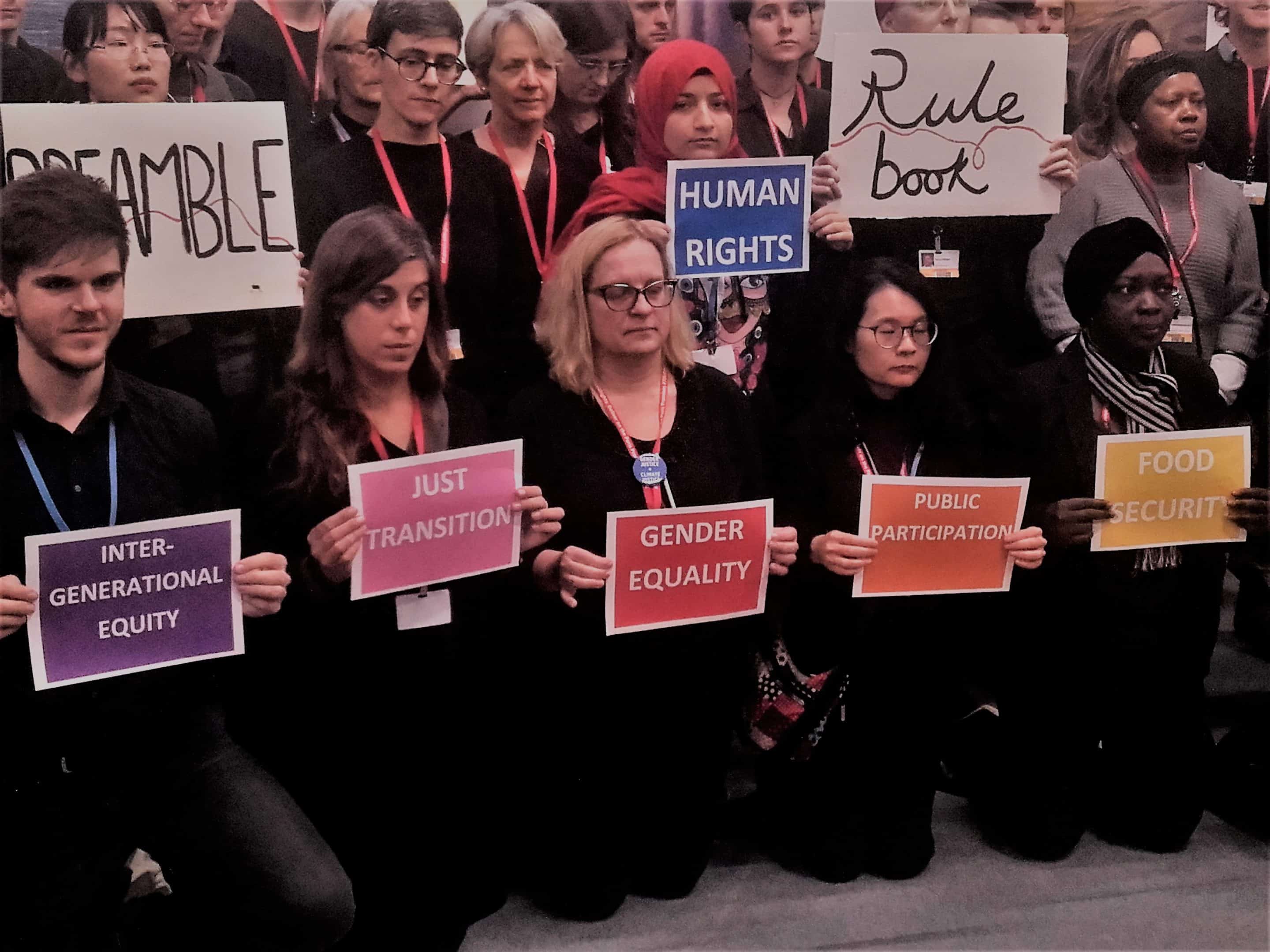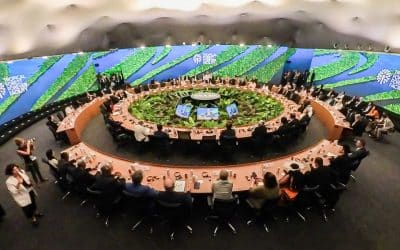Le « Manuel d’utilisation » de l’accord de Paris (rebaptisé par certains le « Manuel d’utilisation de Katowice ») a été le principal résultat de la 24e Conférence des parties à la Convention-cadre des Nations Unies sur les changements climatiques (CCNUCC COP24), révélant les risques d’un système d’engagements volontaires. À Katowice, un accord déjà faible a été davantage dilué lors de la négociation des procédures de sa mise en œuvre par le biais d’une soi-disant action collective globale où dominent les entreprises, le lobby des énergies fossiles et de l’agroalimentaire ainsi que les commerçants et les consultants en carbone, tandis que les détenteurs de droits, les femmes, les peuples autochtones, les jeunes et les communautés locales ont été ignorés. Dans ce processus contrôlé par le monde des affaires, l’objectif poursuivi semble être celui d’empêcher le système des Nations Unies de tenir les pollueurs responsables et d’appliquer les règles de manière efficace.
Continuer a lire en anglais…
The 133-page COP24 outcome does not reflect the extreme urgency of climate action, the impacts of raging storms, forest fires, floods, droughts and extreme weather conditions. The Katowice Rulebook fails to even ‘welcome’ the findings of the IPCCC report and scientific evidence of the impacts of climate change. Instead, it is driven by the goal of economic growth, investment opportunities and ‘feasibility’. The Paris pathway clearly lacks ambition and political will, meanwhile 2030 is not far away.
The final texts regarding Nationally Determined Contributions (NDCs) and the Transparency Framework are inadequate, limiting the scope of NDCs to mitigation and leaving behind adaptation. Pre-Paris pledges of the combined NDCs already failed to meet the main Paris target of limiting global temperature rise to well below 2°C, and countries are now under no obligation to ensure that their climate pledges are in line with the overall goals. In a voluntary, country-driven process, they will largely determine their own accounting rules and provide information according to agreed guidelines.
The current Global Stocktake and review mechanism not only lacks teeth with which to undertake a true and robust accounting of progress towards the Paris goal, but also fails to facilitate increased ambition and improve countries’ disastrously insufficient commitments. The Katowice Rulebook simply reiterates the request in the Paris Agreement for countries to communicate and update their contributions to reduce emissions.
While climate-vulnerable countries are being asked to pay high premiums to companies from the Global North for disaster risk insurance, developed-country governments continue to evade their historic responsibility for loss and damage. The same governments are also let off the hook for their commitment to provide $100 billion per year in climate financing, which is being masked under neo-liberal financial instruments of multilateral and bilateral loans, equity and blended finance. The timeline of 2025 for setting a new collective, quantified goal for climate finance taking into account the needs and priorities of developing countries is vague to say the least.
The negotiations on market mechanisms under Article 6 of the Paris Agreement proved too controversial for the Polish Presidency of COP24, and the text failed to make it into the Rulebook. Deep divisions among Parties arose around issues related to avoiding double counting, international transfers out of the NDCs such as CORSIA (the Carbon Offsetting and Reduction Scheme for International Aviation), the Clean Development Mechanism (CDM) under the greenwashed guise of the Sustainable Development Mechanism (SDM), and the inclusion of REDD+.
The differences extend to the issue of the efficacy and credibility of market mechanisms to address the climate crisis, given that Article 6 is supposed to increase ambition and lower mitigation costs. While Brazil, Bolivia, and Ecuador refused to bring land and forests under the market mechanism, Brazil was not in favour of the accounting protocols related to double counting. Emerging economies led by Brazil opposed a new set of rules for the CDM transition, while the Coalition for Rainforest Nations made a last-minute demand to include REDD+ in the negotiating text. In the absence of a concrete work programme, the non-market approach under Article 6.8 remained relatively untouched and lacked any progress.
The renewed effort to bring forests under Article 6 through REDD+ increases the implications of COP24 for forest policies under the Paris Rulebook. The Rainforest Nations are not deterred from selling their forests to the highest bidders, as implied by the Costa Rican Minister, at a time when ten years of review of REDD+ projects by CIFOR indicates that they have failed to fulfil the goals of the programme. REDD+ has not delivered on its promises; instead, it has proven to be an inherently flawed mechanism that can be used to alter forest policy to benefit corporations and markets. Forest loss is high and growing. Results-based payment was not quick and easy to implement, and REDD+ never received the funding it required. The CIFOR Review explains that REDD+ projects did not deliver on human well-being and that issues of tenure, rights, and gender remain unresolved. Not coincidentally, consultants such as Ernst & Young are talking about the REDD+ Catalytic Fund and scaling up REDD+.
Embedded in the Paris Agreement is an approach to forests as mere carbon sinks to offset carbon emissions from industry and fossil fuels. Article 4 of the Agreement states that Parties should aim to ‘achieve a balance between anthropogenic emissions by sources and removals by sinks of greenhouse gases’. The entire climate convention framework lends credence to the notion of forests serving as carbon sinks to offset emissions, leading not only carbon trading but also bioenergy to be included with carbon capture. This blatantly ignores the fact that forests are indispensable to biodiversity, food, and livelihoods, and that, when used harmoniously by communities living in forests, they can be conserved while also providing food and protection for numerous species. Any reference to removal in the Katowice Rulebook could still have the same implications. The inclusion of emission removal and/or emission avoidance in Article 6.4 can be interpreted as explicitly including REDD+.
The Ministerial Katowice Declaration on Forests, propped up by the Polish Presidency, further conforms to this notion. The Declaration affirms that all types of forests and trees constitute a ‘keystone in achieving a balance between anthropogenic emissions by sources and removals by sinks’ and recognises the need to reduce emissions from deforestation and forest degradation.
A Rulebook that is purged of all references to human rights, focuses on mitigation, lacks any firm agreement on the flow of financing, and overlooks the gap between what is being done and what is required, is evidence of just how little a multilateral climate policy influenced by climate deniers and corporate interests can do to respond to the urgent and immediate demand for climate action. While maintaining pressure on the UNFCCC and the negotiating governments to strive for real, bottom-up climate solutions, it is time to focus on national-level actions and bringing indigenous peoples, women, and local and vulnerable communities together with their alternatives, traditional knowledge and methods of community conservation, to the forefront.
*Souparna Lahiri is a climate campaigner at the Global Forest Coalition




